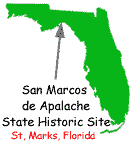
Reservations for
Florida State
Parks are now
made through
Reserve America,
toll free, at
1-800-326-3521
|
SAN MARCOS DE APALACHE STATE
HISTORIC SITE
During the past
four centuries numerous New World travelers have staked their claim at historic
San Marcos de Apalache.
HISTORY
The site's history began in 1528 when Panfilo de Narvaez arrived with 300
men. Having traveled overland from Tampa, Narvaez impressed by the area
located at the confluence of the Wakulla and St. Marks rivers, built and
launched the first ships made by white men in the New World.
In 1539, Hernando de Soto,
along with 600 men, followed the same route taken by Narvaez. Banners
were hung in the trees near the river to easily mark the river's entrance. (A lighthouse now stands near the site.) 
By 1679, the Spanish Governor
of Florida started construction on the first fort built at the junction
of the two rivers. The logs used were coated with lime to give the appearance
of stone. The fort stood only three years, then was burned and looted by
pirates. Not until 1718 did Captain Jose Primo de Ribera arrive to construct
a second wooden fort.
FORT
Construction was begun on the first stone fort in 1739. Progress was slow,
and the fort was less than half complete when it was delivered to the English
in 1763 as a result of the war with Spain.
By 1787, Spain regained control
of the fort, reoccupying it for 13 more years. Spanish rule was challenged
in 1800 by a former British officer named William Augustus Bowles. Bowles
attempted to unify and lead an independent Creek nation of 400 Indians
against the Spanish, eventually capturing San Marcos. His rule ended five
weeks later when the Spanish returned with a flotilla of nine ships to
retake the fort. Because of continuous Indian raids in Georgia from Spanish
Florida, General Andrew Jackson invaded the territory in 1818 and took
San Marcos. Two captured British citizens, Robert Ambrister and Alexander
Arbuthnot, were tried and found guilty of inciting Indian raids. Jackson
executed both of the men, creating a diplomatic crisis between the United
States and Great Britain. Jackson withdrew from San Marcos, leaving the
fort once again in Spanish hands.
In 1821, Florida was ceded
to the United States, and U.S. troops were sent to occupy the fort. Three
years later, the fort was abandoned and turned over to the Territory of
Florida. By 1839, the fort was returned to the U.S. Government and construction
of a federal marine hospital began 18 years later utilizing stones from
the spanish fort. The hospital, which was finished in a year, provided
much needed care for victims of yellow fever.
The final
confrontation at San Marcos occurred in 1861 when the Confederates took
the fort, renaming it Fort Ward.
A Union squadron blockaded the
mouth of the St. Marks River from 1861 until 1865. The Battle of Natural
Bridge eventually stopped the Union force that apparently intended to advance
onto the fort from the rear.
ACTIVITIES
Today, a visitor center containing exhibits and artifacts
covering the area's history is built on the foundation of the old marine
hospital. The historic site and visitor center are open from 9 a.m. until
5 p.m. Thursday through Monday and closed on Tuesdays and Wednesdays, Thanksgiving,
Christmas and New Year's Day.
A trail takes
visitors on a journey through the historic fortification ruins.

San Marcos de Apalache State Historic Site is located in St. Marks, off S.R. 363 on Old Fort Road.
Contact:
San Marcos de Apalache State Historic Site
1022 Desoto Blvd.
Tallahassee, FL 32301
(850) 922-6007 or (850) 925-6216 |
|



